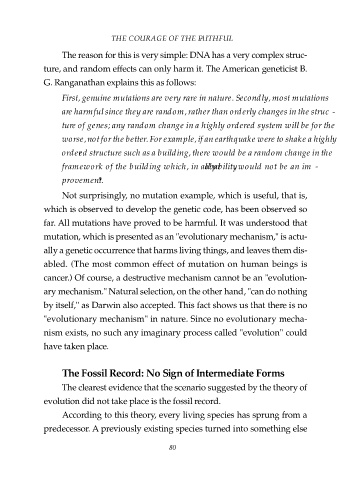Page 82 - The Courage of the Faithful
P. 82
THE COURAGE OF THE FA I T H F U L
The reason for this is very simple: DNA has a very complex stru c-
t u re, and random effects can only harm it. The American geneticist B.
G. Ranganathan explains this as follows:
First, genuine mutations are very rare in nature. Secondly, most mutations
a re harmful since they are random, rather than orderly changes in the struc -
t u re of genes; any random change in a highly ordered system will be for the
worse, not for the better. For example, if an earthquake were to shake a highly
o r d e red structure such as a building, there would be a random change in the
framework of the building which, in all pro b a b i l i t y, would not be an im -
p ro v e m e n t .
9
Not surprisingly, no mutation example, which is useful, that is,
which is observed to develop the genetic code, has been observed so
f a r. All mutations have proved to be harmful. It was understood that
mutation, which is presented as an "evolutionary mechanism," is actu-
ally a genetic occurrence that harms living things, and leaves them dis-
abled. (The most common effect of mutation on human beings is
c a n c e r.) Of course, a destructive mechanism cannot be an "evolution-
ary mechanism." Natural selection, on the other hand, "can do nothing
by itself," as Darwin also accepted. This fact shows us that there is no
"evolutionary mechanism" in nature. Since no evolutionary mecha-
nism exists, no such any imaginary process called "evolution" could
have taken place.
The Fossil Record: No Sign of Intermediate Forms
The clearest evidence that the scenario suggested by the theory of
evolution did not take place is the fossil re c o rd.
A c c o rding to this theory, every living species has sprung from a
p re d e c e s s o r. A p reviously existing species turned into something else
80

